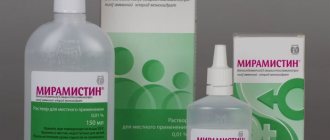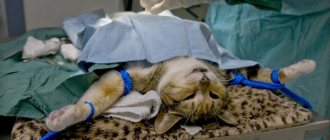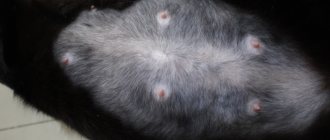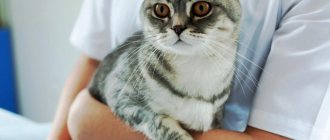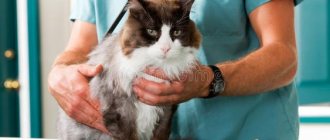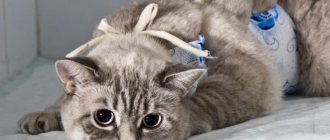Owners, when deciding to sterilize a cat, worry that their pet’s behavior will change. She will be withdrawn, unaffectionate, gain weight, and become lazy. However, there is not a single scientific study that would prove that a cat’s behavior changes in a negative direction after sterilization. On the contrary, castration reduces or completely stops irritability caused by hormonal surges during estrus, aggression in the struggle for “male” attention.
Cat's well-being and behavior
After sterilization, the animal's condition will change every day. If you answer the question: how many days does a cat get sick after sterilization, then the average recovery process lasts a week. It is worth examining this issue in more detail.
First day
During the first 24 hours, the kitten will hardly eat. The animal will continue to recover from anesthesia. The state will be lethargic, drowsy, and coordination of movements will be impaired. Some pets begin to suffer from hallucinations.
The latter can be noticed if the operated patient suddenly gets up and runs or crawls to an unknown location. She may crash into a wall, fall, or fall asleep. Such reactions are considered completely normal, so owners should not worry.
Sometimes females cannot blink. Then you should help her by closing her eyes until the cat herself can reproduce a similar action. If you do not help her, there will be a risk of the cornea drying out and eye problems will begin.
Another common consequence of sterilization on the first day is involuntary urination and vomiting. Owners are advised to be close to the animal to prevent possible injuries or to promptly remove a damaged diaper or cloth. In this case, you cannot feed the animal. Water should be given using a pipette or syringe.
The first day becomes a difficult test for all owners of furry happiness, and therefore everyone asks the question even before the operation: “How long does a cat get sick after sterilization?».
Second day
On the second day, the furry miracle will feel better, and the pet’s behavior will be adequate. Owners should monitor the cat more closely: it will have a desire to hide from others in a hard-to-reach place.
As the cat begins to regain its strength, it may bite someone who wants to touch it if it feels pain or discomfort.
Additionally, it is worth noting such behavioral signs as:
- Licking the incision area;
- An excited reaction to extraneous sounds.
On the second day, it is allowed to feed the ward with small portions of food and often give water.
The third day
Already on the third day the cat will fully recover, and this will be proven by the following signs:
- The dream pet will be active. He will become interested in what is happening;
- The animal will begin to go to the tray or toilet on its own;
- Will demand food.
It is recommended to regularly check the female's body temperature. If the readings turn out to be low or high, you will need to immediately contact a veterinarian.
One of the reasons for possible complications lies in the effect of anesthesia on the animal’s body. For example, due to the fact that the painkiller slows down intestinal motility, the animal may have problems with bowel movements. Owners are advised to pay attention to this and help if necessary. This can be done by giving your pet a laxative.
Fourth day
The cat's condition improves and she begins to feed on her own. Urinary and excretory processes will improve. Anesthesia ceases to have a negative effect on the animal’s body.
Fifth day
On the fifth day, regeneration of the cut will begin. The swelling around the area where the stitch was made will gradually subside and scarring will begin. The cat is no longer sick. She runs around the apartment or house, jumping on low surfaces.
Last two days of the week
By the end of the week, the pet's strength finally returns. The scar gradually heals, the kitten becomes quite active, and an appetite begins to appear. It is also worth noting that the pain experienced by the pet in the first three days disappears.
When to castrate a cat
Castration is a surgical procedure in which an animal's gonads are removed. It is recommended to castrate cats at the age of 8–12 months, when puberty ends. After castration, animals are not capable of reproducing offspring, their signs of sexual behavior disappear, and their aggressiveness decreases.
Most often, owners decide to castrate a cat so that the cat does not mark in the house, and also hoping to reduce the aggressiveness of the animal. Sometimes castration is necessary for medical reasons (orchitis, trauma, pathologies of the development of the gonads). It is believed that this operation prevents the development of diseases such as prostatitis, prostate tumor, and perianal gland adenoma in adult cats.
What affects the cat's condition after surgery?
A week is an average indicator, and you should not rely only on it. Some pets have a hard time with any type of surgery, and some begin to run already on the second day.
Among the signs affecting the cat's condition are:
- Age. The older the animal, the more difficult it is for it to withstand the intervention of a surgeon;
- Type of procedure. For example, if the surgery is an emergency, recovery may take longer;
- Type of anesthesia. Some medications may make the kitten's condition worse.
Thus, when thinking about the question of how long a cat is sick after sterilization, it is worth taking into account the factors listed above and drawing a conclusion.
Medicinal support
All medications must be approved by a veterinarian!
Painkillers:
- Rimadyl (carprofen) – intravenously or subcutaneously at a dose of 4 mg/kg (equivalent to 1 ml/12.5 kg of weight) once a day;
- Tolfedine (tolfenamic acid) – 4 mg/kg once a day orally with food;
- Ketofen 1% (ketoprofen) – subcutaneously, intramuscularly or intravenously at a dose of 2 mg/kg (or 0.2 ml/kg) once a day and no longer than 3-4 days;
- Loxicom (meloxicam) – 0.1 mg suspension/kg orally on the first day once, 0.05 mg/kg on subsequent days.
Seam treatment products:
- Chlorhexidine 0.05% (aqueous solution) - water the seam through a dispenser or drip from above using a pipette until healing;
- Dioxidine 0.5% - use similarly to Chlohexidine;
- Veteritsin spray - spray the suture area 1-2 times a day before removal;
- Aluminum spray - spray on the seam every few days until healing;
- Chemi spray - treat the seam once a day until healing;
- Levomekol ointment - apply around the wound once a day, under a bandage.
Antibiotics:
- Sinulox (amoxicillin + clavulanic acid) – intramuscularly once a day at a dose of 0.5 ml/10 kg for 3-5 days;
- Amoxicillin 15% – subcutaneously or intramuscularly 1 ml/kg (in terms of 15 mg/kg) once for 5 days.
General strengthening drugs:
- Gamavit - the first 2-3 days at a dose of 0.5 ml/kg of body weight, then up to two weeks at a dose of 0.1 mg/kg.
Hemostatic agents:
- Travmatin - intramuscularly or subcutaneously 0.5-1 ml 2-5 times a day;
- Etamsylate – 0.1 ml/kg twice a day.
Is the animal in pain?
After the operation, the kitten will still be under anesthesia, so they will not feel any pain. They will most likely appear on the second day, and among the main signs of possible behavior are:
- Manifestation of aggression. The animal may attack when the owner tries to touch;
- Dilated pupils;
- Gaze directed at one point;
- Refusal to eat;
- Staying in one position for a long time.
To help the female cope with the condition, you can give her painkillers or give her an injection. Before using medications, you should consult your veterinarian about their possible use.
Long-term consequences
Some owners express fears that after the operation their pets will become much less affectionate and, in addition, will quickly gain excess weight. This is nothing more than idle fiction! Your cat will definitely not become less affectionate; Rather, she will simply settle down due to the general stabilization of hormonal levels. As for laziness and gaining excess weight, strictly speaking, in theory this is possible. But exclusively against the background of a sharp decrease in physical activity (you know why) with a simultaneous increase in the amount of food eaten! Therefore, the schedule of games and activities for your furry pet needs to be seriously adjusted, and the problem of excess weight will not arise. A lot of food plus little activity - this happens to people too, right?
Take care of your cat's proper, balanced diet. Try to purchase products from manufacturers that have proven themselves in the market. It is better to select specialized food and avoid excessively high-calorie and fatty foods.
In other words, the motto for the future healthy and long life of a family pet should be: “Proper nutrition plus physical activity.” Let’s add on our own: plus your care, affection and attention!
Original post: Cat Behavior After Spaying. Author: Sandy Chebat Source and photo:
Why does a cat have increased activity?
Due to individual characteristics, pets can recover almost immediately after surgery, showing their usual activity. It is worth noting that they do not feel any discomfort at all and continue to behave as before sterilization.
Unfortunately, such activity becomes a risk to the health of the animal. In addition, such behavior negatively affects his recovery.
Active cats can be aggressive. This is expressed in attempts to bite and scratch anyone who wants to touch them.
Veterinarians recommend:
- Limit the movement of the animal. This can be done with your own hands, creating artificial barriers, closing rooms;
- Ensure complete rest;
- Use sedatives by adding them to water and food.
It is better for owners to prepare for possible attacks of active behavior in advance. A suitable solution would be to create a cool and isolated place for the cat where it will be moved after surgery.
Reasons for sterilization
Usually, a breeder does not think about a procedure that will deprive a cat of the opportunity to become a mother immediately after purchasing a kitten, which touches with its childish carefreeness. However, as the animal gradually matures, its behavior changes, and some of its characteristics may prompt the owner to carry out this procedure. The main reasons for sterilization are:
- Health risks associated with pregnancy and childbirth,
- The uncertainty of the fate of newborn kittens,
- Cats, like cats, mark their territory with urine,
- Prevention of cancer and infectious diseases of the genital area,
- Excited behavior of an animal during estrus.
It is the last factor that has the greatest influence on breeders, since the cat’s behavior after puberty turns a quiet kitten into a meowing and purring cat around the clock, and this will continue for 1-2 weeks, or until pregnancy occurs. This behavior is formed by ancient instincts of attracting a male, and only a change in the hormonal background after sterilization can correct this situation.
© shutterstock
Is cat aggression fixable?
There are often cases when a kitten after surgery begins to snarl, yell, hiss, growl and rush at its owners. This means your pet is experiencing severe pain or nausea. The owners should take this point into account and do everything necessary to alleviate the condition of the ward.
The best solution would be to visit a veterinary clinic. The doctor will examine the female, identify the cause of the behavior, and prescribe appropriate treatment.
It is worth additionally noting that pets may scream if the operation was not completed completely. The sound made does not mean aggression, but a desire to see and feel the cat nearby. To get rid of the screams, a second operation will be required.
General care characteristics
After sterilization, cats look dirty. There may be blood on the fur. But bathing the animal for the first ten days is strictly prohibited . Avoid contact with water.
It is also very important to follow the following rules:
- do not give the animal any antibiotics;
- as a filler for the tray, use special store-bought sand, or even better, cut paper;
- change the filler and thoroughly “wash” the tray after each stool.
- Another important point that is very scary. After sterilization, animals often sleep with their eyes open. This is considered normal. To prevent drying out, you need to instill eye drops with a special solution. It is also recommended to close and open the animal’s eyelids every half hour while sleeping.
Caring for a cat after home sterilization requires not only patience, but also love.
Frightened and suffering from pain and hormonal changes, the animal needs affection. The owner’s emotional mood will help him survive this difficult period.
During what period can an animal leave?
On average, the operation takes 40 minutes. The rest of the time is spent on restoring the pet. And if we talk about how long a cat will be sick after sterilization, then the period is determined based on the type of anesthesia.
The following are distinguished:
- Muscle relaxant and analgesic. A popular mixture used by most veterinarians. It is considered the most effective among those available, but the main disadvantage is the difficult recovery period. The animal may feel unwell throughout the day.
- Muscle relaxant and epudral anesthesia. Only experienced specialists are allowed to use this mixture. Any error in the pattern can lead to atrophy of the hind legs. The ability to move them will return, but for about two days the pet will move exclusively by crawling. If anesthesia is performed correctly, the body will recover within 8 hours, which is a plus.
- Gas and inhalation. High efficiency and minimal toxicity are the advantages of this option. When choosing this anesthesia, the owner does not have to worry about the pet’s condition, since he will come to his senses almost immediately after the operation is completed.
Possible postoperative complications
Complications after planned surgical interventions develop extremely rarely and, in most cases, it depends on the individual characteristics of a particular animal.
Main postoperative complications:
- Prolonged post-anesthesia hypothermia . If a cat lies for a long time without moving, and its ears and paws feel cold to the touch, it is necessary to check its body temperature. If the readings are below 37°C, you need to put the cat on a warm heating pad, cover it with any natural piece of fabric and contact your veterinarian for advice.
- Intra-abdominal bleeding. If traces of fresh blood are detected in the suture area or from the vulva, with obvious pain in the abdomen and pallor of the skin, you should immediately take the cat to a veterinary hospital to stop possible bleeding in the abdominal cavity. If internal bleeding is confirmed, then repeated surgery is performed.
- Postoperative hyperthermia. If body temperature is elevated for more than 3 days (above 39°C), it is necessary to consult with a veterinarian or take the cat to an appointment for direct examination by a specialist.
- Redness around the stitch and swelling. This condition of the suture is allowed for 3-5 days, provided that there is no discharge from the wound. After 5 days, both redness and swelling will begin to subside and will completely disappear by the time the stitches are removed.
- Rotting postoperative suture. If the cat's postoperative hygiene measures are not followed, dirt may get into the seam, causing it to fester. It is imperative to show the animal to a doctor. If the prescribed drugs for local treatment do not help eliminate such signs, the doctor will have to remove the stitches, remove the damaged areas of skin around the wound under anesthesia and re-suture it.
- Lump on the abdomen in the suture area. If an enlarged area is detected anywhere around the seam, this is a reason to consult a veterinarian. There are two options for lumps after sterilization - this is post-operative swelling, which may have to be opened, or the growth of granulation tissue (“young” skin), which will go away on its own within a month and a half.
How to help a cat?
When rehabilitating a female at home, you need to take into account several recommendations from veterinarians:
- It is better to place the female on the floor, otherwise she may fall from any height.
- The place where the animal will lie should be cool. The use of any heating devices nearby is prohibited. Otherwise, there is a risk of internal bleeding.
- You should place an absorbent diaper under your cat. The pet itself must be placed on its right side to reduce the load on the heart muscle.
- If the patient’s immune system is weakened, it is necessary to arrange for additional vitamins or other medications.
- During the first hours after surgery, it is recommended to measure the furry patient’s body temperature, as well as occasionally turn her over.
- If ulcers, unpleasant rashes or redness are found on the neck, it is recommended to consult a veterinarian to determine the cause.
- If sudden vomiting occurs, it is necessary to turn the animal's head to prevent choking. It is better to read the instructions on how to do this in advance.
- You need to put a post-operative blanket on your pet's head. This will prevent infection from entering the seams and will also prevent scratching.
- It is necessary to carry out regular treatment of seams. The veterinarian will conduct training in advance where he will tell you how to correctly perform such actions.
If the suture begins to bleed, the patient’s breathing worsens (wheezing appears), an uneven heartbeat and redness of the mucous membranes are detected, it is necessary to visit a veterinary clinic. Any complications will be determined by a professional doctor. He will also prescribe the necessary treatment.
General information about the procedure
Sterilization is an operation that results in the removal of the uterus and ovaries in females and testes in males. It would be more correct to call the procedure castration, however, to soften the perception of owners, the concept was replaced by the term sterilization. As you know, a fairly large number of owners vehemently oppose the sterilization of pets, but they are guided mainly by common myths.
Let's figure out what changes in the animal's behavior to expect immediately after surgery and after a long period of time. As part of the questions, it is worth touching on the myths that frighten inexperienced owners and make them refuse to castrate their pets.
This is an abdominal operation that is performed under general anesthesia. In large, modern veterinary clinics, the procedure is performed laparoscopically. The advantages of the laparoscopic method are that there is no suture; the uterus and ovaries are removed through two small punctures in the peritoneum. Since laparoscopic surgery is considered expensive, most owners opt for strip surgery.
To avoid serious complications, before sterilization, it is recommended that the cat be examined for heart, kidney and liver failure. Serious complications can be caused by immunodeficiency, exhaustion, dehydration and other disorders leading to suppressed immunity or slowed metabolism.
Note! A common British cat breed, it is considered prone to congenital cardiomyopathy. Before castration of purebred animals, it is strongly recommended to take a blood test and conduct an ultrasound examination of the heart.
Day eleven, removal of stitches
Before the hospital I put a blanket on Alice, she struggled and ran away, but I managed. I also didn’t want to get into the carrier. She meowed pitifully all the way. There's another nurse there again. She ruined the whole impression of the hospital; if the doctor and nurses were friendly and inviting, then this woman amazed me. She didn’t let me take off the blanket herself; she demanded that I take Aliska by the scruff of the neck. When I didn’t understand, she picked it up by the fur herself. I categorically refused to do this. The nurse grumbled that the cat would scratch her. And I was “scratched” by the negativity coming from her.
The stitches were removed quickly, the nurse and I held, and the doctor removed. They paid 100 rubles to remove the stitches.
The threads are pulled out
Preparing for surgery
To make it easier for your cat to tolerate anesthesia, you should not feed it before surgery. The last portion of food is given at least 12 hours before. Anti-flea treatment is required. To prevent the cat from damaging the seam in the future, its claws must be trimmed in advance with a special nail clipper. The animal is usually transported in a carrier bag; you can use a bag made of thick material or a backpack for this purpose. If the distance to the clinic is short, it is better to walk and try to prevent the cat from becoming stressed and panicky.
Second day
In the morning at five o'clock I started looking for Alice. Masha (the owner) doesn’t have a cat, there’s no cat in the kitchen. Nowhere. It turns out that he is sleeping, or rather, lying, next to my sofa. She began stroking and climbed onto the sofa. I fell asleep there. I tried to give her some water - she refused, I wet her tongue, and that was all I could do. Then she gave wet food from her palm and ate a little. Now he sleeps on the sofa.
So she slept almost the whole day, gave her jelly-like Felix from the palm of her hand two more times - this is her usual food. And in the evening I already came to my bowl and ate almost half a bag and drank water.

